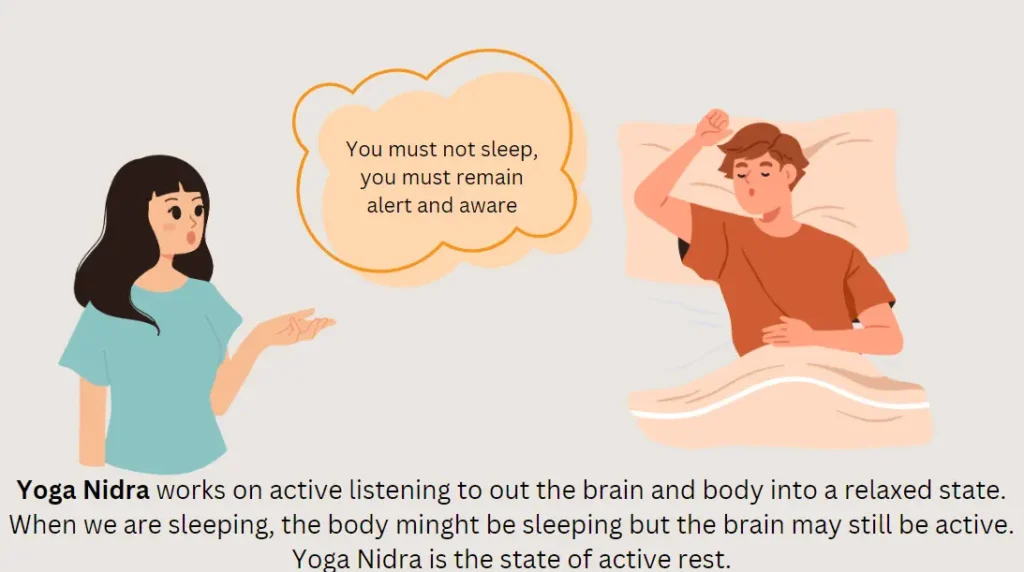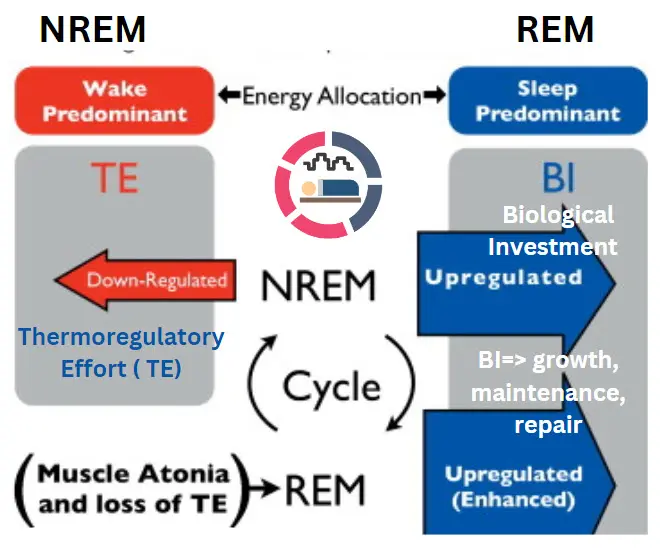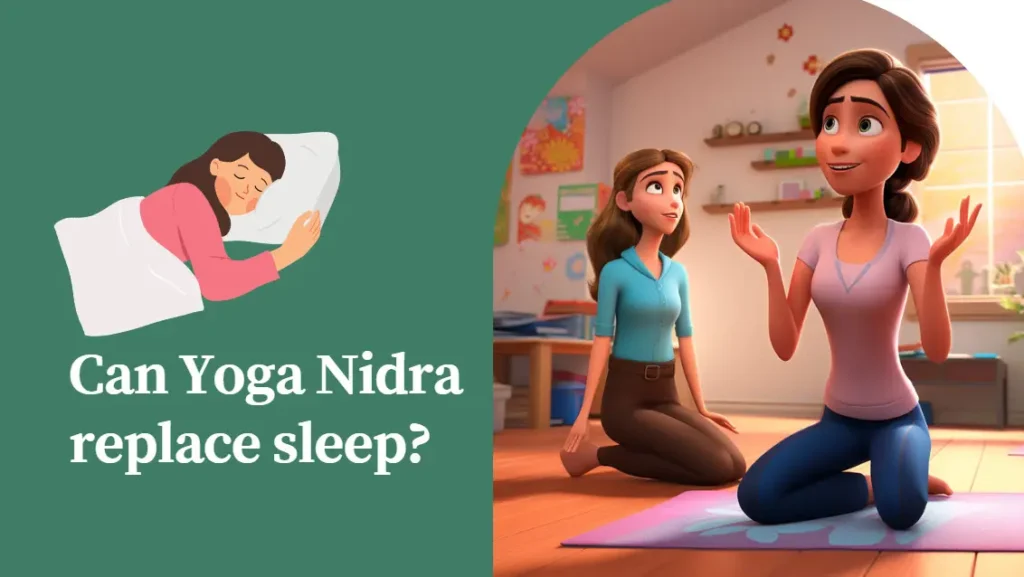Sleep and yoga nidra are two methods to relax the body. Can yoga nidra replace sleep? Or are they different?
Sleep vs Yoga Nidra
After our Yoga Nidra session today, someone raised the question, “If one hour of Yoga Nidra is four hours of deep sleep, then can I replace my sleep with Yoga Nidra?” Now, this question has come up numerous times ever since I began adding a generous 15-20 mins of Yoga Nidra and Non sleep deep rest techniques at the end of my Yoga sessions where many students would complete the session feeling fresher than when they had started, or those who came in with headaches after a long day at work, found that they no longer had a heavy head by the time we finished. In fact, numerous students would call me the next day and say that they had minimal soreness when they practiced the Yoga nidra at the end of their workouts or before bedtime.
This question therefore becomes pertinent- Can Yoga Nidra replace sleep? To answer this question let us dig deeper into understanding the nature of Yoga Nidra or Yogic sleep. Yoga Nidra is a yoga technique that helps you relax into deeper restful states. Yoga nidra is a type of ‘turning in’ of senses (the concept of Pratyahara) that may induce sleep sleep states and we will discuss the science behind yoga nidra and how it could be used to treat insomnia and how it can change the quality of your sleep itself.

Can yoga nidra replace sleep?
Think of Yoga Nidra as a complementary tool to sleeping. But Yoga Nidra is not a subsitute for sleep.
“Yoga Nidra can help take someone who’s in a state of sympathetic nervous system dominance(fight or flight) and bring them into a state of parasympathetic nervous system dominance. In other words, it takes one from the fight-or-flight state to the rest and digest state that is also called the relaxation response state that’s clear and that’s obviously of great benefit to many many people. It allows your mind to feel safe in its surroundings.
I believe the claims about the lower need for sleep stemming from the belief that people want to use the maximum amount of waking time in a day to do their work and live their life, not realizing that sleeping less than 7-8 hours a night is deeply impacting their longevity and the quality of their waking time.

Now, the maximum amount of healing happens when we are in a deep rest state and Yoga Nidra takes us into those deep non-rem states quickly where the brain enters the Theta and Delta state. So it is assumed that when we sleep, the body cycles through these delta-wave states and potentially restores itself faster hence, one may experience the reduced need for sleep or substitute sleep for Yoga Nidra. However, this isn’t true and potentially dangerous.
The human body needs its 7-8 hours of restorative sleep every night that flows with the body’s circadian rhythm. There is a science behind why the body needs to shut down at night and one should stay away from any excess light and use of technology during this period because the body is not only restoring and regulating itself but also working on optimal balancing of hormones, regenerating cells and healing- repairing the body internally which, one or even two hours of Yoga Nidra will simply not do. What Yoga Nidra can do, is that it can support healing patterns of sleep at night and one practicing Yoga Nidra in the afternoon or anytime during the day, people have been found to induce deeper rest periods at night. In this sense, Yoga Nidra is a powerful tool to induce deeper restful time periods, greater healing, improves cognitive abilities, speeds up the body’s healing capacity, increases neuroplasticity in the brain and is most importantly used to optimize night time sleep so that the brain can process information and create deep neural pathways of long term learning that will support us through our lifetimes.
How much Yoga Nidra to do and how often?
Yoga Nidra, like yoga in general, is a practice where you get better at it the more you do it and the longer you do it. The more mindfulness you can maintain throughout the practice it gets better. If you practice Yoga Nidra daily and for an unbroken period of time, it brings about deeper states of rest and rejuvenation. A good way to start this is doing a daily 10 minutes practice and see the benefits kicking-in.
Refer to this video also https://www.youtube.com/watch?v=k9Zhji7eCLI
Yoga Nidra also has different varieties and levels of intensity. A traditional session can last anywhere between 10 mins to a proper 45 min session. This leaves the practitioner feeling as good as new. Though there hasn’t been any research showing how many times a day is optimal, 1-2 rounds of Yoga Nidra everyday is usually recommended by teachers.
Is yoga nidra the same as deep sleep?
Deep sleep is one of the stages of the sleep cycle and is crucial for physical and mental restoration. During deep sleep, the body undergoes various processes such as tissue repair, immune system strengthening, and memory consolidation. It’s a state of unconsciousness where the body is fully at rest, and brain activity slows down significantly. Deep sleep is essential for overall health and well-being.

Yoga Nidra, on the other hand, is a guided meditation technique that aims to induce a state of deep relaxation while maintaining awareness. It’s often practiced in a lying down position, and the practitioner is guided through a systematic process of relaxation, body scanning, breath awareness, and visualization. The intention of Yoga Nidra is not to induce the same physiological effects as deep sleep but to facilitate deep relaxation, release stress, promote mindfulness, and access a state of profound tranquility. It can be a valuable tool for reducing stress, improving sleep quality, and enhancing mental clarity.
While both deep sleep and Yoga Nidra involve relaxation and rest, they serve different purposes. Deep sleep is a natural physiological state that supports the body’s restoration, while Yoga Nidra is a conscious relaxation practice that aims to induce relaxation and mindfulness.
Which NSDR does Huberman recommend?
Andrew Huberman has mentioned that Non sleep Deep rest or NSDR is an umbrella term that contains all forms of deep rest techniques ranging from Yoga Nidra , hypnotherapy, visualizations , breathwork etc. He has even created a tool kit here, that helps people optimize their deep sleep. Each type of NSDR has a slightly different function on the spectrum of rest and alertness.

How is yoga nidra different from meditation?
Yoga Nidra and meditation are both practices that promote relaxation, mindfulness, and mental well-being, but they have distinct differences in their techniques, objectives, and effects. Think of the difference between broccoli and cauliflower. They’re both from the same family, have similar flavors but differ in color and properties. Similarly, Yoga Nidra and Meditation can both be ways to gain deeper insight into the self, bring calm, clarity and alertness but the process and methods are different.
Here’s a comparison of the two
1. Technique– Yoga Nidra Vs Sleep
- Yoga Nidra: Yoga Nidra, often referred to as “yogic sleep,” is a guided relaxation technique that involves lying down and being led through a series of body scans, breath awareness, and visualizations. The goal is to induce a state of deep relaxation while maintaining awareness.This is done while lying down.
- Meditation: Meditation encompasses a variety of practices that aim to quiet the mind and enhance mindfulness. Meditation techniques that involve focused attention on an object, mantra, or the breath is the step before meditation called Dharana or one pointed attention. When one observes thoughts, sensations, and emotions without attachment, Meditation ‘happens’. One cannot ‘do’ meditation. Furthermore, Meditation is usually not done lying down- you can sit or walk in meditation.
2. Objective– – Yoga Nidra Vs Sleep
- Yoga Nidra: The primary objective of Yoga Nidra is relaxation, stress reduction, and rejuvenation. It’s often used to release physical, mental, and emotional tension and promote a deep sense of calm. The Swamis or monks used Yoga Nidra to learn sacred texts, music, different languages etc in a state of sleep.
- Meditation: The goals of meditation can vary based on the technique and tradition. Generally, meditation aims to cultivate awareness, mindfulness, inner peace, and insight. It can lead to improved focus, emotional regulation, and a deeper understanding of one’s thoughts and emotions.
Both Yoga Nidra and Meditation can be used to journey into the self.
3. State of Consciousness: – Yoga Nidra Vs Sleep
- Yoga Nidra: In Yoga Nidra, you aim to remain in a state between wakefulness and sleep. While your body is deeply relaxed, your mind remains awake and attentive. You have to keep resisting sleep. This opens the doorway to the subconscious mind.
- Meditation: Meditation involves various states of consciousness, ranging from focused attention to expanded awareness. Some forms of meditation may lead to altered states of consciousness or deep states of concentration. There is a deeper play when one works on dissolving their small selves into the superconscious self.
4. Practice Length: Yoga Nidra Vs Sleep
- Yoga Nidra: A typical Yoga Nidra session can last anywhere from 10 to 45 minutes, sometimes even longer.
- Meditation: Meditation sessions can vary widely in length, from just a few minutes to hours, depending on the technique and the individual’s preference.
5. Effects: Yoga Nidra Vs Sleep
- Yoga Nidra: The effects of Yoga Nidra often include deep relaxation, reduced stress, improved sleep quality, and a sense of mental clarity and well-being.
- Meditation: The effects of meditation can include improved focus, increased self-awareness, reduced anxiety, enhanced emotional regulation, and a greater sense of connection and inner peace.
So, while both Yoga Nidra and meditation are practices that promote relaxation and mindfulness, they have different techniques, objectives, and outcomes. Yoga Nidra is a guided relaxation practice aimed at inducing deep relaxation, while meditation encompasses a broader range of practices with various objectives related to mindfulness and self-awareness.
Why does yoga nidra work?
Yoga Nidra works through a combination of psychological, physiological, and neurological mechanisms. Its effectiveness can be attributed to its ability to induce a state of deep relaxation, promote mindfulness, and engage the body’s natural healing processes. Here’s why Yoga Nidra is effective:
1. Induces Relaxation Response: Yoga Nidra guides participants through a systematic process of relaxation, leading to a reduction in the body’s stress response. This activates the parasympathetic nervous system, which is responsible for the “rest and digest” state, promoting relaxation and healing. Life is good when you’re relaxed!
2. Accesses the Subconscious Mind: During Yoga Nidra, individuals are in a state between wakefulness and sleep. This allows them to access the subconscious mind more readily, which can lead to increased self-awareness, introspection, and the potential for resolving emotional and psychological challenges. This activates your intuitive capacity as well.
3. Releases Tension and Stress: The guided body scan and relaxation techniques used in Yoga Nidra help release physical, mental, and emotional tension stored in the body. This can lead to a sense of lightness, ease, and reduced muscle tension. Sometimes you can feel some parts of the body shaking or shuddering or jerking up in Yoga Nidra, there can be a physical and energetic release happening. Let it happen.
4. Enhances Mindfulness: Yoga Nidra encourages participants to maintain awareness throughout the practice. This mindfulness cultivates a non-judgmental awareness of thoughts, emotions, and sensations, promoting a sense of detachment and emotional balance.
5. Promotes Deep Rest: Yoga Nidra provides a way to achieve deep rest without actually sleeping. This can be especially beneficial for individuals who struggle with sleep issues or those seeking relaxation during the day. Sometimes when I practice Yoga Nidra in the day, or even before sleep at night, my night sleep is deeper and more still.
6. Influences Brain Waves: Yoga Nidra can lead to shifts in brain wave patterns. The practice often moves individuals into the theta brain wave states, which are associated with relaxation, creativity, and a receptive state of mind.
7. Boosts Self-Healing: By promoting relaxation and reducing stress, Yoga Nidra supports the body’s natural healing processes. This can lead to improved immune function, better digestion, and enhanced overall well-being. It activates the body’s natural healing mechanisms and promotes repair.
8. Facilitates Mental Rejuvenation: The state of relaxation induced by Yoga Nidra allows the mind to rest deeply while maintaining awareness. This rejuvenation can enhance cognitive function, improve mood, and foster mental clarity.
9. Alters Neurotransmitters: The relaxation response triggered by Yoga Nidra can lead to the release of neurotransmitters such as serotonin and dopamine, which contribute to feelings of happiness and well-being. On practicing Yoga Nidra, it becomes so much easier to step into learning with an open mind but also at the same time brings awareness when the body needs to take a step back to rest. With Yoga Nidra we learn not to be in auto-pilot in our waking states and makes us much more aware of ourselves and our surroundings.
Conclusion: Yoga Nidra & Sleep are complimentary
So, in conclusion, Yoga Nidra works by creating a unique state of conscious relaxation that engages the body’s natural healing mechanisms, enhances self-awareness, and promotes relaxation and well-being on multiple levels. Its combination of relaxation techniques, mindfulness, and altered states of consciousness contributes to its effectiveness.
Yoga Nidra is indeed a unique modality for healing and deep rest yet and has been clinically proven to be an excellent practice adjacent to a good night’s rest, it cannot be used to substitute the latter. Infact, sleeping at night for 8 hours approx is crucial. Yoga Nidra can only help improve the quality of night sleep and also help the brain delve into deep growth while you are in this state. So use Yoga Nidra to optimize your rest time and learn while you rest!
——
Resources
Link – Yog Sadhna (https://www.yogsadhna.com/) & Sleep Dragon ( https://www.youtube.com/@nsdr-yoganidra)
Link – Insight Timer
Link – The Tim Ferriss Show Transcripts: Dr. Andrew Huberman — A Neurobiologist on Optimizing Sleep, Performance, and Testosterone (#521) – The Blog of Author Tim Ferriss https://tim.blog/2021/07/08/andrew-huberman-transcript/



